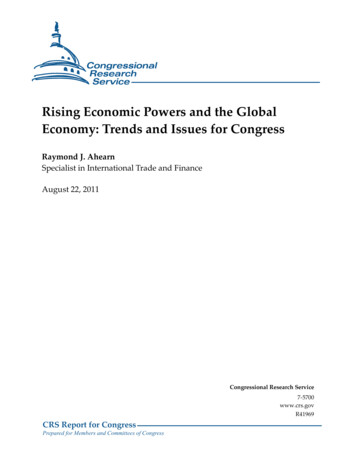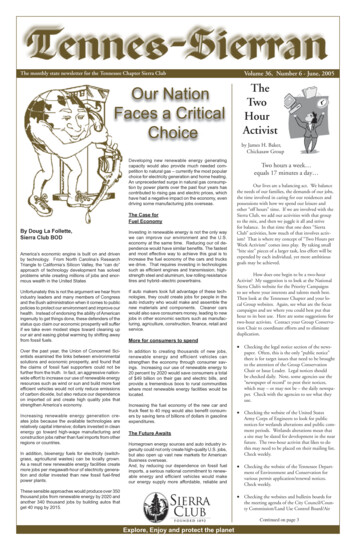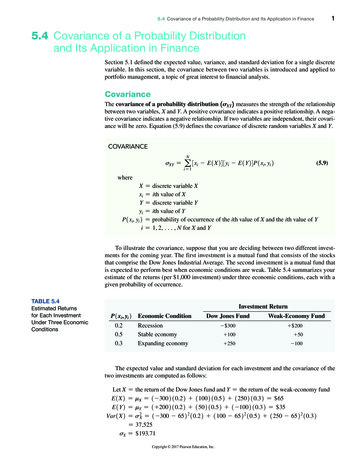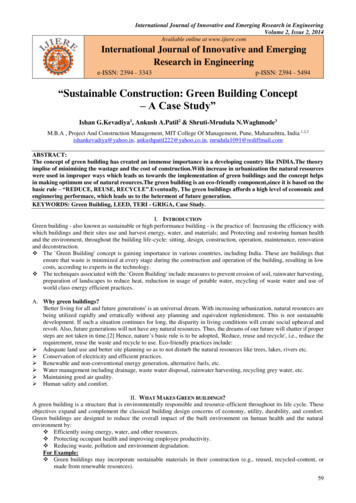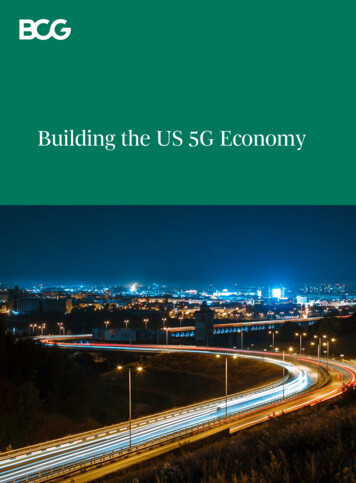
Transcription
Building the US 5G Economy
Boston Consulting Group partners with leaders inbusiness and society to tackle their mostimportant challenges and capture their greatestopportunities. BCG was the pioneer in businessstrategy when it was founded in 1963. Today, wehelp clients with total transformation—inspiringcomplex change, enabling organizations to grow,building competitive advantage, and drivingbottom-line impact.To succeed, organizations must blend digital andhuman capabilities. Our diverse, global teamsbring deep industry and functional expertise and arange of perspectives to spark change. BCGdelivers solutions through leading-edgemanagement consulting along with technologyand design, corporate and digital ventures—andbusiness purpose. We work in a uniquelycollaborative model across the firm andthroughout all levels of the client organization,generating results that allow our clients to thrive.
Building the US 5G EconomyEnrique Duarte Melo, Val Elbert, Antonio Varas, Heinz Bernold, and Helen KondosSeptember 2020
AT A GLANCEAs countries around the world build the next generation of wireless networks, thefocus has been on the global race to 5G. That narrative obscures how the technology will enable economic growth, create new jobs, and drive innovation.The 5G Growth Engine5G networks will improve existing applications and enable innovations that increaseproductivity and cost competitiveness, and improve health and safety. 5G technologiesare expected to create millions of jobs and contribute trillions to global GDP.Five Success Factors for the 5G EconomyOur research suggests that US policymakers should move away from snapshot-intime metrics surrounding the global race and focus on five key success factors—networks, spectrum availability, innovation ecosystem, business climate, andtalent—that will enable a 5G economy to thrive in the long run.The innovation ecosystem and business climate are areas of strength for the US, andoperators are investing aggressively to build out 5G networks. However, it will beimportant for the US to continue to add available spectrum, streamline policiesgoverning the building of cellular infrastructure, and improve labor-force readiness.2 Building the 5G US Economy
The fifth generation of wireless technologies, 5G, promises to catalyze thedevelopment of mobile digital solutions that will help reinvent how businessworks and transform the way people interact with one another. Over the comingdecade, 5G networks are likely to disrupt almost every industry in the world.Most countries and policymakers have been talking about “a global race to 5G,”with a narrative focused on which nation is leading on narrow metrics such as thenumber of 5G subscribers and cell towers at any given point in time. Those numbers may be interesting, but they paint a partial and often misleading picture. 5G’strue significance lies in the fact that it will generate economic growth, create newjobs, and reshape innovation. (See the sidebar “Why Raw Numbers Don’t Tell theTrue Story.”)That’s why we believe US policymakers should fundamentally change how theythink about 5G. Instead of focusing on a global race narrative, they should turntheir attention to these five key success factors that will allow the building of the5G economy in the US and enable it to thrive over the next decade. Spectrum Availability. To unlock the full potential of 5G networks, wirelessproviders need a sufficient mix of low-, mid-, and high-band spectrum, whichshould be made available through a market-based, transparent set of forward-looking auctions. Networks. Capital investments by cellular-service operators have been, and willcontinue to be, critical for building the 5G network infrastructure. A reducedregulatory burden at all levels of government will speed infrastructure buildout, which is necessary to increase subscriber penetration, the key measure ofnetwork reach. Innovation Ecosystem. US government policies should encourage ampleprivate-sector R&D spending and provide strong IP protection to nurture avirtuous cycle of innovation and development. Business Climate. A combination of access to funding, openness to risk, andbusiness-friendly policies will create an environment that is conducive totechnological innovation. Talent. To ensure that the US workforce has the skills necessary for future technological changes, tech-related certification and degree training will be critical.Boston Consulting Group 3US policymakersshould turn theirattention to these fivekey success factorsthat will enable the5G economy to thriveover the next decade.
WHY RAW NUMBERS DON’T TELL THE TRUE STORYMany articles in the media frame theissue of the 5G economy as a globalrace to 5G and claim that the US islosing to China, or vice versa. Thedata used to support this claim isconsistently based on raw numberssuch as the number of 5G cell towersor the number of 5G subscribers. Butsuch comparisons are not particularlyuseful to evaluate a country’s 5Gnetwork deployment, let alone itsstanding in the 5G economy.Japan, for instance, initially led in the3G economy. Its integrated mobileinternet service shaped a strongbusiness case for network investmentand new applications. Its 3G penetration rate was initially significantlyhigher than that of the US andEurope, according to a report fromRecon Analytics. Japan’s populationwas only about 40% that of the US, sothe US still had a higher absolutenumber of 3G subscribers than Japandid. However, the US penetration ratewas not high enough to sustain thebusiness case for investment. Thesame dynamic will play out in the 5Gera, so simply comparing the numberof subscribers countries won’t beuseful in tracking progress or makinginvestment decisions.Headlines comparing the totalnumber of 5G cell towers in a countryare even less relevant. 5G coverage isa function of more than the rawnumber of cell sites—and themethodology used to count suchwireless infrastructure—and includesgeography, population density, thenumber of population centers, thetype of spectrum used, and the typeof technology. Any meaningfulcomparison of countries’ 5G progressmust include the penetration rateover time.US progress on the key success factors suggest areas of both strength and room forimprovement. While the innovation ecosystem and business climate are excellent,and operators are investing aggressively to build out 5G networks, the addition ofmore available spectrum—midband in particular—will be important, as will becontinuing the streamlining of policies governing the building of the cellular infrastructure and labor-force readiness.The Three Phases of 5G GrowthThe 5G economy is likely to grow in three distinct phases. (See Exhibit 1.) Robust5G networks that provide better data speeds, increased device density, and improved latency will constitute Phase 1. These networks will serve as the backboneof future economic growth.In Phase 2, rising 5G penetration rates will enable transformational innovationthrough 5G-based use cases and improvements in existing applications. As the decade progresses and the 5G economy enters Phase 3, fully realized 5G-based usecases will deliver benefits to every citizen and business through higher productivity,improved cost competitiveness, and better health and safety. These phases willoverlap; some applications will improve even as the networks are being built.4 Building the 5G US Economy
Exhibit 1 5G Will Be the Foundation for Tomorrow’s EconomyBroadbenefitsA robust 5G network will bring significant direct benefits: More data, more devices, and increased speed A better network experience for US citizens and businesses5G-enableduse cases5G-enabled use cases are key to building the 5G economy: Extreme mobile broadband Fixed wireless access Massive IoT (consumer wearables, logistics and tracking) Mission-critical IoT (e-health, connected vehicles)Robust5G networkBroad societal benefits will include: Improved productivity Improved cost competitiveness for US companies Improved health and safetySource: BCG analysis.The evolution of the 5G economy will be similar to that of the 4G economy. Thefirst 4G network in the US was launched in 2010, and by late 2014, penetrationrates had reached 50%. At the same time, companies had developed new devicesand apps designed to take advantage of the greater network speeds. By the end ofthe decade, 81% of US adults owned a smartphone. The app economy had grownto contribute 4.7 million jobs and nearly 570 million to US GDP by 2018, accordingto trade group the App Association. And because of 4G, the wireless industry’s contribution to the US economy more than tripled in the same period.1 The 5Geconomy is likely to have an even greater impact on everyday life and business inthe 2020s.Phase 1: Robust 5G Network Buildout. 5G networks will provide the technologicalfoundation for economic growth in this decade because they will allow: Faster Data Speeds. Download speeds will be 40 times faster than they aretoday. More Connected Devices. The maximum number of devices that can functionin a specific area, known as connection density, will increase tenfold.Boston Consulting Group 5
Instant Response. Latency, that almost imperceptible pause before datatransfer begins, will decrease, resulting in response times that are roughly10 times faster than at present.US wireless providers are already building networks and providing 5G servicesacross the country. As the networks expand and the subscriber base grows, the consumer and business experience improve.Phase 2: 5G-Enabled Use-Case Development. Increasing 5G penetration rates willspur improvements to existing wireless applications and the development of newapplications that will be the building blocks of the 5G economy. (See Exhibit 2.)Future 5G use cases can be broken down broadly into four types: Extreme mobile broadband (eMBB) will allow for mobile videoconferencingwithout lags, high definition mobile streaming in crowded areas, and morestable connectivity. Fixed wireless access (FWA) will leverage networks to bring broadband serviceto homes and businesses. This will expand both high-speed internet connectivityand consumer options. Massive Internet of Things will rely on an extremely high density of connecteddevices. Its creation will be aided by the lower power consumption of 5Gnetworks, which will extend sensors’ battery lives and minimize the need forreplacements, especially in hard-to-reach places.Exhibit 2 New and Improved Use Cases Will Drive the 5G EconomyConsumer(wearables, smart home, AR gaming)Sensor networks(smart cities, precision agriculture)Public safety(gunshot detection, AR-assisted firefighting)Industry 4.0(self-optimizing production, inventorymanagement, AR-assisted jobs)Logistics and trackingE-health(connected ambulances,AR-enabled telemedicine)Fixed wireless accessExtreme mobilebroadband(streaming, conferencing,virtual offices, broadband incrowded areas)AConnected vehiclesuse casesBExtreme mobilebroadbandFaster and more reliableuser experiencesFixed wirelessaccessUltrafast, high-capacitystationary broadbandCMassive IoTEfficient and low-costcommunications withdeep coverageDMission-critical IoTUltralow latency andhigh reliabilitySources: 3GPP; Qualcomm; NGMN Alliance; BCG analysis.6 Building the 5G US Economy
Mission-critical IoT will benefit from 5G networks’ ultralow latency, enhanced security (allowing for the transmission of sensitive data), and newnetwork flexibility.The evolution of 5G networks, and the investment costs of building them in a country as large as the US, will cause the types of use cases created in the near term tovary from those developed in the mid- to long term. In the short run, eMBB andFWA will become more widely available. Verizon already offers FWA 5G plans tocustomers in six cities. In February 2020, the National Football League teamed upwith Verizon to outfit Hard Rock Stadium in Miami with 5G network coverageduring Super Bowl LIV to demonstrate eMBB’s capabilities in a crowded setting.These are early examples, but as the US moves from building robust 5G networksto expanding use cases, both eMBB and FWA will likely increase.Massive IoT and mission-critical IoT will develop more slowly. They will pop upacross industries and consumer subsets in a small way, but the full benefits of theseuse cases will likely be realized later in the decade. For example, making self- driving cars a reality will require ultralow latency and redundant 5G networks inevery area that a car can go. In the medium term, semiautonomous driving technologies will aid truckers on major transit routes as well as urban commuters in citiesthat have high-band 5G networks. Massive IoT and mission-critical IoT will eventually transform transportation as similar changes take place in other sectors.Phase 3: Broad Benefits. As 5G networks get better in each phase, they will enablethe creation of digital offerings that provide many kinds of benefits to people andorganizations. 5G applications will transform almost every major industry in theUS. They are likely to lead to greater labor productivity, boost companies’ globalcompetitiveness, and improve public health and safety. In fact, 5G could well proveto be the key driver of national competitive advantage in the 2020s—just as USleadership in 4G technologies drove economic growth in the previous decade.For example, companies will be able to use sensors connected to 5G networks toimprove their ability to track raw materials and components throughout their supply chain. That will help employees, who will be able to collaborate remotelyand conference on the go, to optimize transportation routes and reduce inventoryrequirements.Similarly, 5G networks will help build the factory of the future. Employees wearingAR glasses will be able to analyze the status of machines, get expert advice in realtime, and update operational parameters while staying safe. Sensors with extremelylow latency will ensure that robots and employees can work alongside each otherand instantly communicate to optimize their actions. The cost reductions broughton by these processes may be great enough to bring more manufacturing—and theassociated jobs—to the US.In another area, 5G-enabled telemedicine, combined with augmented reality (AR)applications, will increase access to health care providers on the go. During emergencies, smart city sensors will allow the deployment of faster, more informedemergency response teams.Boston Consulting Group 75G applications arelikely to lead togreater labor productivity, boost companies’ global competitiveness, and improvepublic health andsafety.
Even those futuristic projections offer only a sneak peek at 5G’s potential. Whenthe first US 4G network launched in 2010, no one predicted that 4G would lead tothe creation of ride-sharing services, which were available to 75% of the US population by 2015; music streaming services, which accounted for 80% of the US musicmarket by the middle of 2019, according to the RIAA; and the huge expansion inthe number of mobile apps. These wireless services changed everyday life for people in less than a decade.Global Leadership in Wireless Network TechnologyA new region or country has led the way in rolling out each generation of wirelesstechnologies and with that head start has been first to reap the larger economicbenefits. (See Exhibit 3.) After analog cellphones started making inroads in theWest, European market leaders together created the global system for mobile communication (GSM) standard, which allowed them to form a broadly unified userbase and dominate the 2G market.By the end of the 2G era, spectrum-related regulations increased licensing costs anddelayed commercial investment in 3G networks in Europe, so the region ceded itsdominant position to Japan. This came as the economic impact of network technology was increasing because of the advent of mobile internet access. Japan becamethe leader of the 3G economy, as the country boasted an integrated mobile internetservice that shaped a strong business case for investment in the mobile networkand its applications.Japan was well-positioned to lead the 4G economy, too. It was among the first countries to launch 4G networks and was able to use the high-speed broadband of 4G tolaunch the apps economy. However, the lack of an open ecosystem for digital content and application development around the dominant operating system slowedJapan’s ability to develop a full-fledged 4G economy outside its home market. Thatopened the door for the US.Exhibit 3 The Evolution of Network gvoiceDigitalvoiceMobilebroadbandHigh-speed broadbandand the app economyInterconnected devicesand sensorsHuman-to-humanEarly mobile phonesLow-speed data,voice, and some textHigh-speed dataand internet accessIP-based network,high-speed internet,streaming, appsExtreme mobilebroadband, connectedsystems, industry 4.0Sources: US Senate; Ofcom; BCG analysis.8 Building the 5G US Economy
How the US Came to Lead the 4G EconomyDuring both the 2G and 3G eras, the US was slow to roll out networks, leading tosluggish growth in penetration and longer waits for those networks to reach a critical mass of subscribers. In the second half of the 3G decade, however, some keyshifts took place. Advanced smartphones began hitting the market and US regulators made important policy decisions, which led to increased investment by US telecommunications companies. (For example, in 2009, the Federal Communications Commission adopted a shot clock to expedite tower siting, establishing timeframes for state and local governments to review proposed wireless deploymentsand modifications.)The US also benefitted from the rapid auctioning off of spectrum by the FCC andincentives that prompted spectrum holders to make spectrum available to other users. From there, competition among wireless network operators ensured significantinvestments in building networks. However, being the first to launch a network isn’tenough; Sweden and Norway were actually the first to launch 4G networks. It’s important to ensure that network penetration attains a critical mass quickly, so there’sa market for applications and a platform for investment and innovation. By 2015,over 50% of adults in both the US and Japan had 4G subscriptions—a higher percentage than in most European countries, according to the World Cellular Information Service.In addition to the networks, several drivers led to US leadership of the 4G economy.The US combined its innovation environment, talent, and a favorable business climate with widespread 4G networks to get ahead. Using the talent pool and resources from its personal computing industry, the US created an ecosystem forapp- centric innovation and entrepreneurship. That allowed 4G technologies to p ermeate the US economy over the course of the decade.The US took an early lead in innovation, and by 2012 patents for mobile servicesaccounted for more than 20% of the total of those issued in the US annually. Innovation translated into economic growth; Silicon Valley’s ample early-stage fundinginteracted with a relaxed business environment, and job creation ensued. A virtuous cycle began as US tech hubs with expertise in software and digital services fueled additional growth in jobs, concentrating talent by drawing entrepreneurs,technical experts, and creative designers, from around the world.Each wireless network generation has brought with it new devices and applications,enhancing its impact on the economy. Thus, the 5G stakes are higher than ever today.Five Success Factors for the 5G EconomyEvery country in the world will eventually benefit from 5G networks, which is whywe suggest that policymakers pivot away from the idea of a global race and focuson the 5G economy holistically. This will require a forward-looking, substantive setof metrics to measure broad progress and capture how other industries will leverage 5G networks. Our research, based on what made the US lead the developmentof the 4G economy, shows that a country must manage five factors simultaneouslyto create a best-in-class 5G economy.Boston Consulting Group 9Each wireless networkgeneration hasbrought new devicesand applications,enhancing its impacton the economy. Thus,the 5G stakes arehigher than ever today.
Networks. Widespread network deployment is critical to laying the foundations ofthe 5G economy, and rapidly achieving high penetration levels. A network obviously needs infrastructure, but real value is unlocked when consumers and businessestake advantage of faster and more reliable connectivity. In the US, cellular serviceproviders built out nationwide 4G networks quickly and an increasing 4G penetration rate followed.In terms of infrastructure, the US government in the 4G era created a regulatoryframework that incentivized investment and helped promote a competitive wireless market. That will be particularly important for 5G networks because theywill require a denser wireless infra structure footprint, though the antennae willbe smaller.Spectrum is thefoundation of theentire mobile communication system.Governments mustprovide cellularservice providerssufficient spectrum ina timely fashion.To enable 5G’s higher data capacity, there must be a concurrent increase in thebackhaul, the link between the antenna and the core network. That will requirethe rollout of fiber-optic cables (fiber, for short).2As networks are built, it is important to measure consumer penetration rates.The 5G economy will not move from Phase One to Phase Two until a large proportion of consumers have started using the networks. Historically, global market leaders have enjoyed penetration rates of 10% to 20% by year two, whichfor 5G would be the end of 2021. (As this report was being published, the full impact of the COVID-19 pandemic was still impossible to predict. Consequently, uncertainty surrounds the effect it will have on 5G development and con sumer take-up.)Spectrum Availability. Spectrum, a scarce resource, is the foundation of the entiremobile communication system. Governments must provide cellular service providers sufficient spectrum in a timely fashion. In the case of 4G, the FCC rapidlyauctioned off spectrum even as US policymakers incentivized spectrum-holders,including federal government agencies, to make it available to other users if theydid not need it. The availability of spectrum is no less important in the 5G era thanit was in the 4G era, and the government must continue make it available in allthe relevant spectrum bands, especially midband. (See the sidebar “The Types of5G Spectrum.”)Innovation Ecosystem. R&D spending and IP protection will help the developmentof innovative new 5G services and foster cross-industry collaboration. A strong innovation ecosystem is already in place in the US. Since the early days of 4G, the UShas awarded patents two-and-half times faster than the Europe, according toChetan Sharma Consulting. The US tax code also includes a credit for R&D costsincurred in the US, which multiple studies have shown has increased spending onresearch in the US.Business Climate. Concentrated funding, an openness to taking risks, and business- friendly policies will create an environment conducive to wireless innovation. Inthe case of 4G, the US government supported startups, including many app-basedstartups that supercharged the wireless economy, by passing legislation to increaseaccess to funding and easing small business regulations. The world class ecosystem10 Building the 5G US Economy
THE TYPES OF 5G SPECTRUM5G networks need to operate acrossthree different types of spectrum:low-, mid-, and high-band. (See theexhibit below.) Spectrum bands area range of radio frequencies withinthe radio spectrum, which rangesfrom 3 kilohertz (kHz) to 300 gigahertz (GHz). Each band has characteristics that will enable fully realized5G networks and the development ofuse cases.Low-band spectrum enables the useof wireless signals that can penetratewalls to reach deep inside buildingsand cover large geographic areas,which allows for rapid and efficientdeployment across the US. Thesesignals, usually focused on frequencies lower than 1 GHz, provide animprovement over 4G, but peakbandwidth, and, therefore, speeds,will have a lower plateau, andlatency will likely remain greater than10 milliseconds.Midband spectrum offers highercapacity and faster speeds thanlow-band spectrum and allows signalsto travel farther than high-bandsignals. But it cannot penetratebuildings as efficiently and effectivelyas low-band signals and will notunlock the full potential of 5G speedsand response times like high-band.High-band spectrum, also known asmmWave, is key to maximizing speed,minimizing latency, and increasingdevice density in 5G networks. However, high-band signals, generallydefined as greater than 24 GHz, only5G Networks Will Need to Operate Across Three Types of SpectrumHigh-band10 Gbps(mmWave)1 msMidbandLatency 10 msTensofmetersBandwidthCoverageUp to 1Gbps Up to a kilometer 100MbpsLow-band 10 msKilometersMinimal lagand fasterdownloads,but smallercoverage areaA combination ofall three bandswill create arobust 5Gnetwork acrossthe USLargest coveragearea, but longerresponse timeand slowerdownloadsSources: Forbes; IC5G; IMT-2020; OpenSignal; Verizon; BCG analysis.Note: All figures are expected theoretical measurements; experienced speeds and specificationsmay vary. High-band spectrum is generally focused on 24 GHz and above; low-band spectrum isfocused on spectrum of less than 1 GHz.Boston Consulting Group 11
THE TYPES OF 5G SPECTRUM(continued)travel short distances and havelimited penetration. In order to work,they require the deployment of alarger number of low-power basestations (cells) to cover small areas.That makes it too expensive to act asthe baseline network in less populated areas.It’s important to understand thedifferent kinds of spectrum becausethey determine which use cases 5Gwill enable, and when the benefits,such as commercial uses and revenues, will result. In addition to speed,connection density, and latencyimprovements, the establishedprotocol for 5G networks enableslower power consumption by connected devices, enhanced security for datatransmission, and the ability to slicenetworks into virtual networkstailored to the requirements ofspecific applications.for early stage funding in the US has promoted the creation of innovative cellularbusinesses in the past and will continue to do so.Talent. A workforce with the skills to manage technological changes will providecountries with the expertise to build state-of-the-art cellular networks and developnew applications. The mix of digital talent in the US, as well as the conduciveenvironment for entrepreneurship, enabled both innovation and the affordablerollout of 4G infrastructure. The US attracted many immigrants with technical skillseven as its digital and software talent clusters enabled the creation of tight-knitecosystems. Maintaining a highly skilled workforce will be even more important ifthe US is to lead in the knowledge-based 5G economy. It will need talent across theentire value chain: from labor to install the 5G network infrastructure to technicalexpertise to build out applications, such as AR.Measuring US Readiness for Success in the 5G EconomyThat brings us to the key question: Will the US retain its leadership of the globalcellular industry? BCG’s research shows that while the US continues to enjoy anedge in many areas, and is making progress on others, there’s room for improvement in several key areas.NetworksCapital Investments. The level of capital investment per capita by US telecom providers is on par with, and often above, those in other developed countries. Since 2018they have invested around 140 per person a year, including investments in 5G andother wireless networks, according to BCG calculations. This figure is similar to investments made by their counterparts in Germany and Japan but is seven times higherthan those made by Chinese telecoms and twice as much made by South Koreanproviders. Many US telcos are also investing in expanding fiber to increase backhaul.From 2020 through 2025, US operators expect to invest over 250 billion in capitalexpenditures to build 5G networks, more than any other country in the world.312 Building the 5G US Economy
Policies to Support Investments. At the federal level, the FCC has modernized rulesfor building wireless infrastructure in order to speed up the rollout of 5G. However,the interpretation and implementation of those rules by municipalities has oftenbeen inconsistent. Implementing the rules in a transparent, efficient fashion is key,particularly because state and local governments have understandably changed theway they work during the COVID-19 pandemic.Penetration. US cellular providers haven’t yet published 5G-specific data, butindependent estimates suggest that the number of 5G subscribers was limited in2019. The figures are changing rapidly, though, and will likely shoot up once thenumber of 5G-enabled smartphones rises and with the continued deployment of5G networks across the country.Spectrum AvailabilityThe US government has made significant amounts of low- and high-band spectrumavailable to service providers, but, despite ongoing efforts by the FCC, still lags inthe provision of the crucial midband spectrum. Many countries have 200-300 MHzmore sub-6 GHz spectrum available, on average, for 5G than does the US. Thatneeds to change, and soon. The FCC has announced that two auctions of midbandspectrum totaling 350 MHz will begin in 2020, but other countries continue to aggressively move to assign midband spectrum, as well as low- and high-band spectrum, to wireless service providers.Innovation EcosystemR&D Investment. US technology and telecommunications companies spend significantly m
Boston Consulting Group partners with leaders in business and society to tackle their most important challenges and capture their greatest opportunities. BCG was the pioneer in business strategy when it was founded in 1963. Today, we help clients with total transformation





